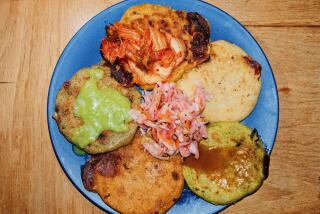Top Salvadoran all dressed up
- Share via
UNCLE CHITO must have been a chef in a fancy restaurant, or maybe he’s just a guy who loves to experiment with gourmet recipes. The salad named for him, Tio Chito’s Salvadoran mix, at Jaragua, a 7-month-old Salvadoran restaurant between Hollywood and Koreatown, has many ingredients you won’t see in other Salvadoran restaurants around town: Gorgonzola, tropical fruit chunks and raspberry vinaigrette. The dressing lightly coats the salad’s baby greens in a style more often found in two- and three-star kitchens.
Just as atypical for its neighborhood is Jaragua’s freshly painted building. Someone with a well-honed design sense has done such an “Extreme Makeover” on this corner storefront, you want to enter just to see what’s going on. The bold, earthy ocher exterior is impossible to miss among the faded panaderias, pupusarias and the occasional Korean sign along this yet-to-be-gentrified stretch of Beverly Boulevard.
Inside, poster-size original oil paintings dominate the muted adobe-colored walls. Their simple, larger-than-life figures, the work of local artist Rafael Escamilla, inject a folkloric yet style-savvy feel to the large dining room.
But the food is even better than the restaurant’s decor. Apart from Uncle Chito’s salad and a chicken Caesar with chipotle dressing, the menu is completely traditional and the Salvadoran cooking is perhaps the most beautifully executed in the city right now.
On the list, we spot a few items we’ve never tried. At dinner one night, we ask our young waitress to explain the “ensalada” drink. She tells us it has fruit chunks, but that doesn’t do justice to the thirst-quenching pineapple-based juice filled with a wild assortment of finely chopped apple, mamay (sapote), cashew fruit and brightened with finely minced watercress.
Naturally, we order pupusas. The griddle-baked tortillas arrive fresh and steamy. When we cut them into quarters to share, we find the thin, expertly hand-patted crusts hold in every drop of their melting, juicy fillings.
I liked the delicate rice pupusa with squash and cheese, but the porkaholics at the table swooned over the chicharron (which in many Salvadoran kitchens, including this one, is similar to carnitas) made with a heartier corn crust.
Shrimp cocktail “en salsa rosada” is a massive goblet mounded with pristinely fresh shrimp and avocado chunks that bob in a pink sauce. The light liquid with a trace of cream tastes nothing like the Thousand Island dressing it looks like.
Try the tipico mixto, a sampler of appetizers that says a lot about the tropical nature of Salvadoran cuisine. Plantains, cooked several ways, are transformed by each method. Crunchy, savory tajadas are the ribbons of thinly sliced, deep-fried green plantain you may know from Cuban restaurants as maraquitos. Ripe and pan-fried, the fruit becomes almost caramelized; mashed, it’s used as a dough for Salvadoran-style empanadas that are filled with a slightly sweet, thickened cream.
The appetizer selection also boasts a stack of salty, crunchy yuca root fries and a pastelito, a golden thin-crusted corn turnover bulging with meaty, braised pork chunks and potato. On the side you always get curtido, a palate-cleansing lightly pickled cabbage reminiscent of spicy coleslaw.
Soups here are meals in themselves -- immense steamy vats of house-made broth loaded with vegetables served with a plate of meat or chicken along with rice on the side. The chef tosses in a scattering of chopped cilantro and yerba buena (mint) to give it a fresh herbal kick.
Most meat prepared in Latin American kitchens is served well done. But at Jaragua, order the churasco tipico medium rare and a hefty slab of grilled rib-eye -- pink inside and running with juices -- is set before you. The steak is accompanied by a parade of nibbles: a slab of fresh white cheese, succulent little sausages, fried plantain and casamiento, a “wedding” of rice and beans cooked into a tasty blend.
Pan con pavo -- a huge sandwich of freshly roasted turkey -- is a thing of wonder. The bird has been rubbed with herbs and spices; these permeate the meat, which is carved to order and piled au jus onto a mayonnaise-slathered roll. A drizzle of cultured cream gilds the lily.
For dessert one night, we try chilate con nuegados, an ancient Indian concoction more often eaten as a snack. The bowl of cornmeal broth laced with allspice and pepper is accompanied by yams and plantains braised in a thick sugar syrup to a jam-like consistency. For Salvadorans, it’s comfort food.
The rest of us can revel in Jaragua’s pink-sauced shrimp cocktail, its turkey sandwich, its pupusas and Uncle Chito’s fabulous salad.
--
--
(BEGIN TEXT OF INFOBOX)
TWO-STAR STYLE: Tio Chito’s Salvadoran mix.
Jaragua Salvadoran Restaurant
Location: 4493 Beverly Blvd., Los Angeles, (323) 661-1985.
Price: Appetizers, sandwiches, salads and cocktails, $6.50 to $9; pupusas, $2 to $2.30; entrees, $8 to $14.
Best dishes: Tio Chito’s Salvadoran mix; coctel en salsa rosada, pastelitos, empanadas, pan con pavo (roast turkey sandwich).
Details: Open 11 a.m. to 10 p.m. daily. Lot parking behind the restaurant. Visa and MasterCard.
More to Read
Sign up for The Wild
We’ll help you find the best places to hike, bike and run, as well as the perfect silent spots for meditation and yoga.
You may occasionally receive promotional content from the Los Angeles Times.






